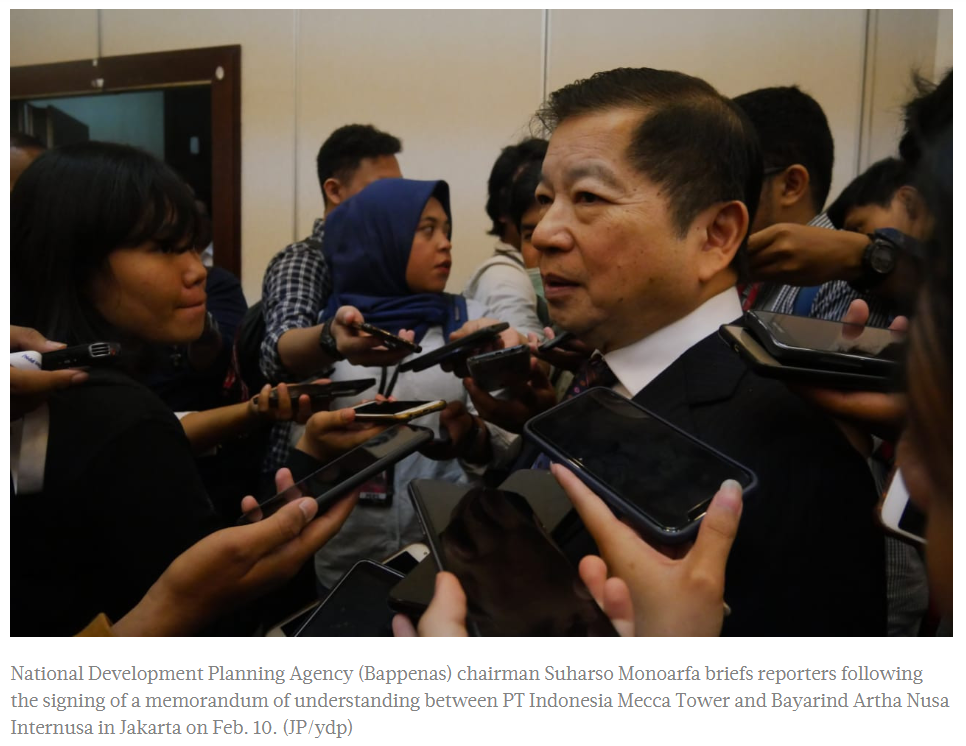Indonesia: Government to allocate extra spending of Rp 56 trillion in 2021 to revive economy
The government plans to allocate an additional Rp 56.5 trillion (US$3.8 billion) to a number ministries and agencies in 2021 to revive the economy, according to the National Development Planning Agency (Bappenas).
Bappenas chairman Suharso Monoarfa said on Tuesday that the extra funds would be allocated to cover non-operational expenditures for the economic recovery and social security programs, as the agency had projected a spike in unemployment and the poverty rate due to the harsh impacts of emergency measures imposed to halt the spread of COVID-19.
“Budget allocation for ministries and agencies’ non-operational expenditure will increase by 55 percent or Rp 56.5 trillion, which will be used [to fund] infrastructure projects, human capital development and other prioritized sector projects,” he said during the agency’s national meeting.
The agency projects unemployment numbers to increase by 4.22 million people in 2020, with the open unemployment rate estimated to spike to around 7.8 and 8.5 percent, far beyond the 2019 rate of 5.28 percent.
According data published by Statistics Indonesia (BPS), the number of unemployed people in the country increased slightly to 6.88 million in February, from 6.82 million people in the same period last year.
Indonesia’s poverty rate is also predicted to increase by around 0.5 to 1 percentage points in 2020 from the 2019 level of 9.2 percent. In 2021, the poverty rate is also projected to stay at the 9 percent range, Bappenas data shows.
“We have revised our poverty rate target to around 9.2 percent, higher than the 8.4 percent stipulated in the National Medium-Term Development Plan (RPJMN). However, I’m not confident about our revised target as the poverty rate could be above the target,” Suharso said.
Bappenas set a pessimistic tone in its poverty and unemployment eradication effort as the government lowered its economic growth target to 2.3 percent for this year under the baseline scenario, and to a contraction of 0.4 percent under the worst-case scenario.
However, the government expects an economic rebound in 2021 with an economic growth rate between 4.5 and 5.5 percent, according to the macroeconomic assumption for the 2021 state budget plan.
Suharso said the additional Rp 56.5 trillion for ministries would be used to support economic recovery efforts focusing on infrastructure construction, tourism and manufacturing, as well as funding for small and medium enterprises (SMEs).
The government will also continue its key projects listed under the RPJMN to help the country’s economic recovery, which include the super priority tourist destination development project and the development of nine industrial zones outside of Java, the agency’s chief added.
Responding to Bappenas’ statement, Gadjah Mada University labor expert Tadjudin Noer Effendi urged the government to be prudent in analyzing the country’s unemployment level before launching large-scale initiatives.
“We have to be careful in establishing unemployment projections during a time of crisis, as there are people who were forced to take unpaid leave, while furloughed informal workers aren’t registered by the Manpower Ministry,” Tadjudin told The Jakarta Post in a separate phone interview.
He added that workers not counted by the government as unemployed could be left out of the government’s social safety net program, which would make the program ineffective.
To reduce unemployment, Tadjudin urges the government to focus on initiating labor-intensive projects and maintaining household spending.
The Public Works and Housing Ministry is among ministries that has reallocated spending to finance labor-intensive projects.
Minister Basuki Hadimuljono said on Monday said that the ministry would allocate Rp 1.8 trillion to fund the projects, which are expected to absorb 78,000 workers in 2,865 locations.
For the second strategy, Tadjudin has called on the government to alter its staple aid program into a cash disbursement program (BLT) for low-income families to keep the economic engine running.
“Indonesia’s household spending accounts for around 57 percent of our GDP. If we want to maintain economic growth, we have to boost the circulation of money at the grassroots level, which could be attained through the BLT program,” he said.
Fitch Solutions projected in April that household spending growth, which accounts for 57.4 percent of GDP, would slow to just 1.2 percent this year from 5 percent last year.
The United States-based institution also revised its forecast for the country’s GDP growth, to negative 1.3 percent this year, compared with 2.8 percent economic growth in its previous projection, as the country is likely to see a slow recovery and remain under lockdown for a prolonged period.
Source: https://www.thejakartapost.com/news/2020/05/13/government-to-allocate-extra-spending-of-rp-56-trillion-in-2021-to-revive-economy.html


 Thailand
Thailand




